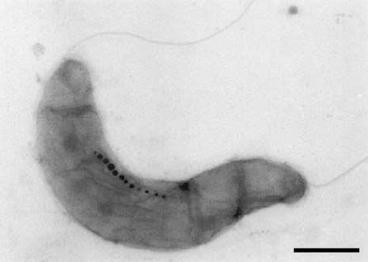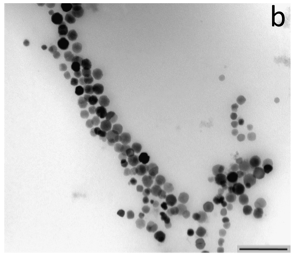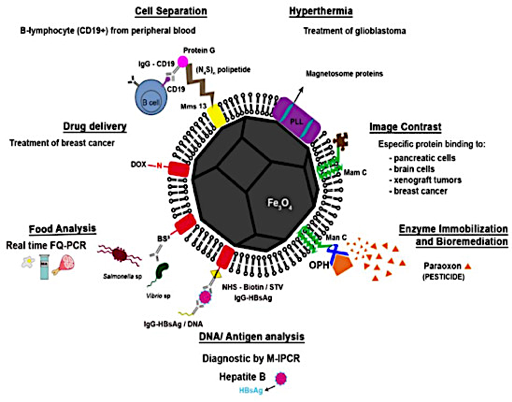Magnetospirillum gryphiswaldense: Difference between revisions
| Line 21: | Line 21: | ||
====Description==== | ====Description==== | ||
[[File:M gryphiswaldense Fig 1.png|frame|'''Figure 1:''' '''''Magnetospirillum gryphiswaldense''''' '''Cell [6].''' ''M. gryphiswaldense'' cells are helical in shape, with flagella at either end of cell. The magnetosomes (location of nanomagnet synthesis) can be seen as small, black dots arranged in a linear configuration. The line of magnetosomes functions as a ‘microbial compass’, allowing ''M. gryphiswaldense'' to align with the geomagnetic field. [6]]]''Magnetospirillum gryphiswaldense'' is microaerophilic, gram-negative, spirilla-shaped bacteria that lives in freshwater aquatic environments with vertical chemical gradients ''(Fig. 1)'' [1,6].''M. gryphiswaldense'' is known for its classification as a magnetoactive bacteria (MTB), which denotes its ability to biomineralize magnetic nanoparticles within its body [1]. These nanomagnets are synthesized and stored within organelles called magnetosomes [1,5]. The magnetosomes are aligned within the cell to create a microbial ‘compass needle’, which | [[File:M gryphiswaldense Fig 1.png|frame|'''Figure 1:''' '''''Magnetospirillum gryphiswaldense''''' '''Cell [6].''' ''M. gryphiswaldense'' cells are helical in shape, with flagella at either end of cell. The magnetosomes (location of nanomagnet synthesis) can be seen as small, black dots arranged in a linear configuration. The line of magnetosomes functions as a ‘microbial compass’, allowing ''M. gryphiswaldense'' to align with the geomagnetic field. [6]]]''Magnetospirillum gryphiswaldense'' is microaerophilic, gram-negative, spirilla-shaped bacteria that lives in freshwater aquatic environments with vertical chemical gradients ''(Fig. 1)'' [1,6]. ''M. gryphiswaldense'' is known for its classification as a magnetoactive bacteria (MTB), which denotes its ability to biomineralize magnetic nanoparticles within its body [1]. These nanomagnets are synthesized and stored within organelles called magnetosomes [1,5]. The magnetosomes are aligned within the cell to create a microbial ‘compass needle’, which interacts with the Earth’s magnetic field [1]. ''M. gryphiswaldense'' motility, powered by two rotating flagella at either end of the cell, is then directed by the interactions between its magnetosomes and the geomagnetic field [1,6] | ||
====Discovery==== | ====Discovery==== | ||
Revision as of 03:56, 1 May 2020
Classification
Domain: Bacteria
Phylum: Proteobacteria
Class: Alphaproteobacteria
Order: Rhodospirillales
Family: Rhodospirillaceae
Species
|
NCBI: [1] |
Magnetospirillum gryphiswaldense
Discovery and Description
Description

Magnetospirillum gryphiswaldense is microaerophilic, gram-negative, spirilla-shaped bacteria that lives in freshwater aquatic environments with vertical chemical gradients (Fig. 1) [1,6]. M. gryphiswaldense is known for its classification as a magnetoactive bacteria (MTB), which denotes its ability to biomineralize magnetic nanoparticles within its body [1]. These nanomagnets are synthesized and stored within organelles called magnetosomes [1,5]. The magnetosomes are aligned within the cell to create a microbial ‘compass needle’, which interacts with the Earth’s magnetic field [1]. M. gryphiswaldense motility, powered by two rotating flagella at either end of the cell, is then directed by the interactions between its magnetosomes and the geomagnetic field [1,6]
Discovery
The first species of Magnetospirillum were discovered independently by two different scientists: Salvatore Bellini in 1963 and Richard Blakemore in 1975 [1]. In Pavia, Italy, Bellini noted a specific microbe that was continually migrating to one side of all the lake water samples that he analyzed [1]. A few years later in Massachusetts, USA, Blakemore observed the same behavior in microbes isolated from marsh mud samples [1]. Blakemore realized that the presence of a magnet caused the migrating microbes to alter their trajectory, and he named this behavior ‘magnetotaxis’ [1].
Since 1975, many magnetotactic bacteria have been discovered. The specific species M. gryphiswaldense was first isolated from sediments in the Ryck River in 1990 by biologist Dirk Schuler, from the Max Planck Institute of Marine Microbiology, and Dr. M. Kohler, a professor at the University of Greifswald in Germany [7,12]. Since the initial discovery of M. gryphiswaldense, extensive lab work and research has been focused on the M. gryphiswaldense strain MRS-1, which has served as an exemplary Magnetospirillum line due to its high-density cell growth [2].
Genome Structure
The complete genome of M. gryphiswaldense was first sequenced in 2014 by Wang X. et. al. using Illumina Solexa and Roche 454 reads [9]. This initial read identified a single circular chromosome with 4,261 coding sequences [9]. A more accurate genome sequencing was performed in 2018 by René Uebe et. al., which again identified a single circular contig consisting of 4,155,740 bp with a G+C content of 63.3% [4,9]. The M. gryphiswaldense genome consists of 3,980 genes, and also contains 88 transposons. This high number of transposons explains why the M. gryphiswaldense genome is so highly flexible and could account for the differences seen between the 2014 and 2018 genome reads [9].
|
Complete M. gryphiswaldense Genome Sequence: [2] |
The Magnetosome Island (MAI)
The ‘Magnetosome Island’ (MAI) is a region of the M. gryphiswaldense genome that is of particular interest because it contains all the genes necessary for magnetosome formation, magnetite crystal growth, and magnetotaxis [1,11]. The genomic region is about 130 kb in size and contains three important classes of genes:
- mam (magnetosome membrane) genes
- mms (magnetosome membrane specific) genes
- mtx (magnetotaxis) genes
All of these MAI genes are controlled by 4 main operons: mamAB, mamGFDC, mms6, and mamXY [1]. Deletion experiments preformed on the M. gryphiswaldense strain MRS-1 suggest that the only genes that are essential for nanomagnet synthesis are those controlled by the mamAB operon [1]. These mamAB-controlled genes contribute to formation of the magnetosome membrane, formation of the magnetite crystal, maturation of the magnetite crystal, and alignment of the magnetosome chain [1]. A study by Wang Q. et. al. revealed the MAI also contains 80 differentially expressed genes (DEGs) (53 upregulated and 27 downregulated), which vary in response to iron concentrations [11].
Evolution of MTBs
There are multiple theories for the evolution of magnetoactive bacteria based on their genetic makeup. Some say that the high conservation of the mam genes suggests a monophyletic origin, where all MTBs shared one common ancestor [1]. However, the rich diversity seen among MTBs could suggest that their evolution stemmed from multiple different lineages, and that the conservation of specific genes was due to a large amount of horizontal gene transfer, rather than a single common ancestor [1].
Cell Structure and Nanomagnet Synthesis
Cell Structure
As previously mentioned, M. gryphiswaldense are spirilla, or helically shaped single-celled microbes with rotating flagella at either end of their bodies [1,6]. Their cell walls are gram-negative, meaning that they lack a thick peptidoglycan layer [5]. M. gryphiswaldense are usually several micrometers long and have a diameter of about half a micrometer [13]. The magnetic moment of M. gryphiswaldense as measured by light scattering was found to be 2.53± 1.6×10^16〖Am〗^2 [1].
While there is not much literature on the reproduction of M. gryphiswaldense research has shown that the turn-around time from initial reproduction to a fully-functioning organism (producing nanomagnets) is about 24 hours under ideal conditions (iron and oxygen conditions) [2].
Nanomagnet Synthesis
M. gryphiswaldense synthesizes nanomagnets made of an iron oxide know as magnetite (Fe3O4), which is the most magnetic naturally occurring mineral on earth [1]. The magnetite nanomagnets are formed through the process of biologically controlled mineralization (BCM), where M. gryphiswaldense creates an organic mold, pulls in iron ions from the environment, and then oxidizes those ions so that they crystalize as magnetite [1]. The nanomagnets themselves are cuboctahedral in shape, and about 40-45 nm in diameter [11].
In M. gryphiswaldense, BCM occurs within the magnetosomes: organelles that each consist of a phospholipid and fatty acid membrane surrounding a growing nanomagnet (Fig. 2) [8]. These magnetosome vesicles the result of cytoplasmic membrane invagination, which occurs before magnetic crystal growth begins [1,11]. Once the magnetosome membrane has separated from the cytoplasmic membrane, its fatty acid and phospholipid proportions are slightly adjusted [8]. At least 18 specific proteins can be found within the magnetosome membrane as well, having attached to the magnetosome membrane either before or after membrane invagination [8]. M. gryphiswaldense arranges these magnetosomes in a linear configuration, held in place by cytoskeletal filaments [1].
Ecology
M. gryphiswaldense can be found in freshwater, aquatic environments where there is vertical chemical stratification (i.e., varying concentrations of oxygen and iron ions within the water) [1]. Specifically, M. gryphiswaldense is highly sensitive to oxygen concentrations; being microaerophilic, they prefer only very low levels of dissolved oxygen (around 0.5-1.0%) [1,6]. M. gryphiswaldense remains at an ideally oxygenated level within its environment through magnetotaxis [1]. The chain of magnetosomes within M. gryphiswaldense allows the microbe to be continually aligned with the geomagnetic field, providing a sense of direction [1]. If oxygen levels are too low, M. gryphiswaldense simply propels itself upwards in line with the geomagnetic field until it reaches an ideal oxygen concentration [1]. Likewise, if oxygen levels become too high, the microbe simpley reverses its direction of flagella rotation, and swims down along the geomagnetic field lines until it reaches lower oxygen levels [1]. By limiting movement to a fixed axis that aligns with the oxygen gradient, M. gryphiswaldense is able to efficiently explore and maneuver within its environment.
Applications
M. gryphiswaldense is potentially a highly lucrative microbe in terms of biotechnology applications because it synthesizes strong nanomagnets with high precision; synthetic nanomagnet production is not nearly as precise or dependable [3]. Magnetosomes can serve a wide range of purposes because they are very small but can still be easily separated from mixtures via magnets [3]. Additionally, the surface properties of the magnetosome membrane make it relatively simple to attach specific molecules to the magnetosome surface (Fig. 3) [10]. Some specific applications for both entire MTBs (including M. gryphiswaldense) and magnetosomes alone are listed below [10].
Magnetoactive Bacteria Applications
- Drug Delivery
- Bioremediation
- Energy Generation
Magnetosome Applications
- Drug Delivery
- Cell Separation
- Food Safety
- DNA and Antigen Recovery or Detection
- MRA Contrast Agent
- Hyperthermia (Fig. 5)
- Enzyme immobilization

References
[4] Magnetospirillum gryphiswaldense (ID 1508). (2014).
[6] [https://doi.org/10.1007/s007060200047 Šafařík, I., & Šafaříkov&#, M. (2002). Magnetic Nanoparticles and Biosciences. Monatshefte f�r Chemie / Chemical Monthly, 133(6), 737–759.]
Author
Page authored by MacKenzie Emch, student of Prof. Jay Lennon at Indiana University.


